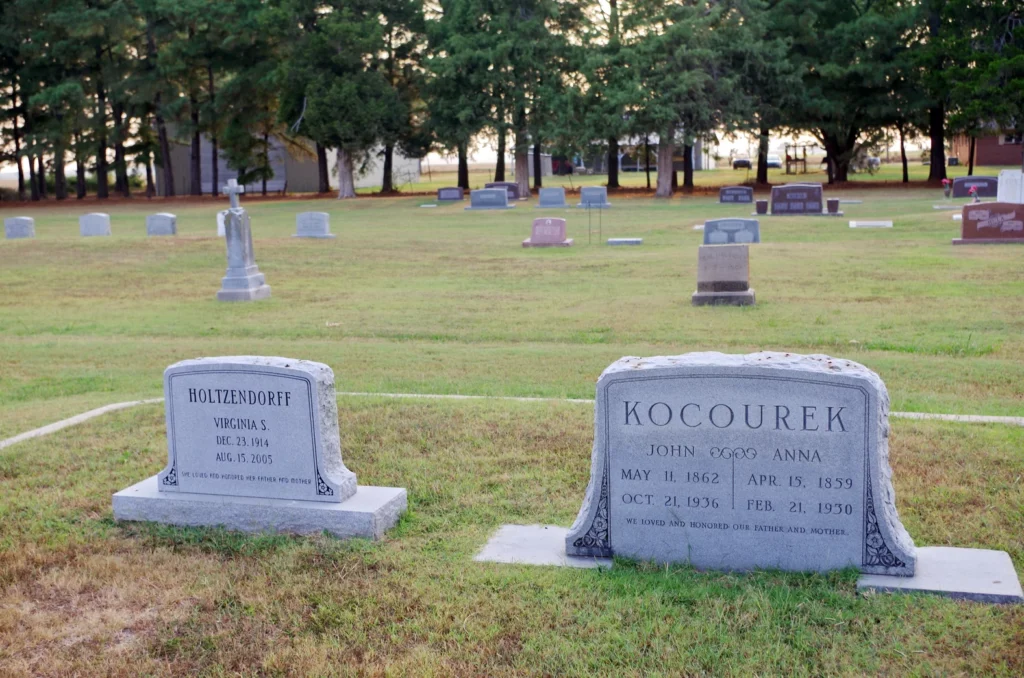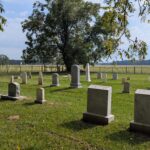

A few years ago, while driving along U.S. Highway 63 from Hazen to Stuttgart, I stumbled upon an unexpected piece of Arkansas history: the Czech National Cemetery. Tucked away just two miles south of Hazen, this quiet cemetery serves as a poignant reminder of the Czech immigrants who helped shape the area in the late 19th and early 20th centuries. What began as a scenic drive soon became a journey into the rich heritage of Prairie County’s Eastern European settlers.
As I pulled off the road, the cemetery came into view, its modest entrance marked by a brick arch that proudly bears the name “Czech National Cemetery.” Towering cedar trees stood as sentinels, their branches swaying gently in the breeze. The air carried the unmistakable scent of freshly mown grass. The stillness was striking, and in that moment, I couldn’t help but reflect on the lives memorialized here—immigrants who had come to this unfamiliar land seeking new opportunities and a better life for their families.
A Historical Legacy
The cemetery was established in 1894, at a time when many Eastern European settlers, particularly those of Czech, Bohemian, and Slovak descent, were moving to Prairie County. Promoted by organizations like the National Slovak Society, these immigrants were drawn to Arkansas’ Grand Prairie for its fertile farmland and potential for a prosperous future. The town of Hazen, incorporated in 1884, quickly became an economic hub for the surrounding area, offering not only land but also opportunities for trade and business.
The story of the Czech National Cemetery begins with John Kocourek, a Bohemian land agent from Hazen. During a recruiting trip to Ames, Iowa, Kocourek fell seriously ill. After being evicted from his hotel due to his illness, he was taken in by John and Anna Hondl, a Czech family who nursed him back to health. In gratitude, Kocourek shared with the Hondls tales of the rich farmland awaiting them in Arkansas. Soon, the Hondls packed up their belongings—loading livestock, equipment and household goods into three railroad boxcars—and made the long journey south.
Tragically, shortly after arriving, John Hondl was struck by lightning while working in a hayfield. His wife, Anna, chose a one-acre site on their farm for his burial, and with the help of their neighbor, Peter Marak, who donated an adjoining acre, the cemetery was born. Over the years, it would become the final resting place for many Czech families, memorializing the struggles and triumphs of these early immigrants.
Cultural and Community Significance
Walking among the gravestones, it’s impossible not to feel the weight of history. These markers tell the story of a community that left everything behind to forge a new life in a foreign land. The names etched into the stones—Kocourek, Marak, Poduska—represent some of the families who were instrumental in shaping Hazen’s growth. Some of their businesses, like the Kocourek and Son Hardware Store, became local institutions, passed down through generations until the late 20th century. Edvard Benes, a cousin of the Benish family in Hazen, even went on to serve as president of Czechoslovakia from 1935 to 1938.
The cemetery itself has evolved over the years. In the 1960s, the original wooden fence was replaced with a brick wall and a decorative metal archway. In the 1980s, a drainage system was installed to protect the low-lying land from flooding, and a perpetual care fund was established to ensure the cemetery’s upkeep. Despite these changes, it remains a humble yet significant site—one that continues to serve the community today.

For me, standing in this cemetery was a deeply moving experience. It reminded me how history can often surprise us, especially in the most unassuming places. This serene spot holds the stories of Arkansas’ Czech immigrants, but it also offers visitors a chance to reflect on the broader history of the region. Whether you’re tracing family roots, interested in local history or simply enjoy visiting historical sites, this cemetery is well worth the detour.
If you’re ever in the area, I encourage you to visit. The Czech National Cemetery, listed on the Arkansas Register of Historic Places since 2010, is more than just a historical footnote—it’s a place where the past continues to speak to the present, reminding us of the generations who built the communities we now call home.
For more information, visit argenweb.net/prairie/Cemetery/czech.htm.
P.S. You can use this link to share this post: https://downhomearkansas.net/the-czech-national-cemetery-a-reminder-of-arkansas-eastern-european-heritage.

Keith “Catfish” Sutton of Alexander, Arkansas, is one of the country’s best-known outdoor
journalists. His stories and photographs about fishing, hunting, wildlife and conservation have
been read by millions in hundreds of books, magazines, newspapers and websites. He and his
wife Theresa own C&C Outdoor Productions Inc., an Arkansas-based writing, photography,
lecturing and editorial service.




Get DownHome Arkansas blog posts, news, and more directly by email. Give us your name and email if you’d like to subscribe.